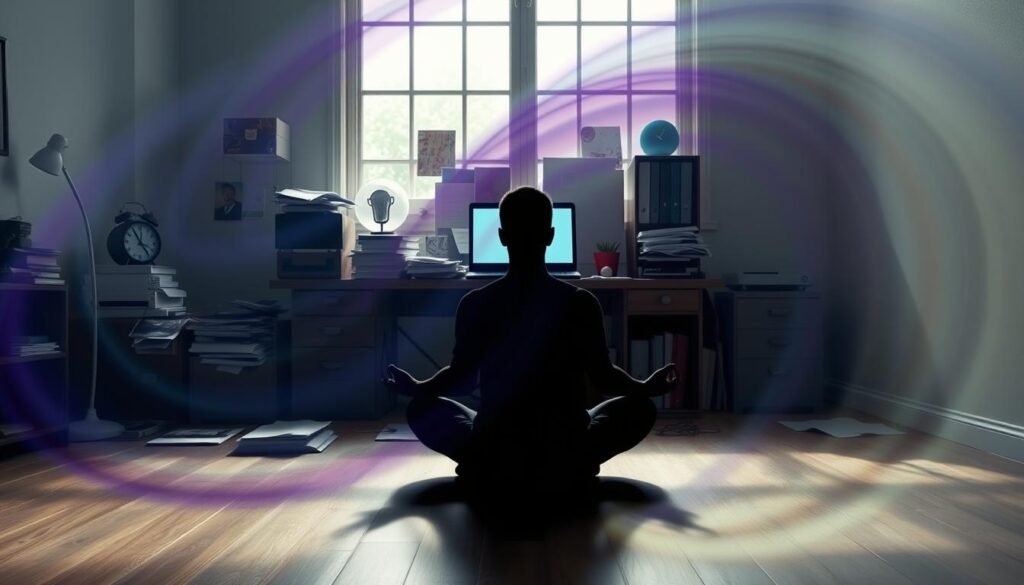About 31% of adults in the U.S. might face an anxiety disorder at some point. This shows how common anxiety problems are. It’s key to recognize the symptoms of anxiety attacks because they’re more intense than normal worry. Understanding these symptoms can help manage overwhelming feelings linked to anxiety disorders.
Anxiety attacks don’t happen suddenly. Instead, they build up over time, unlike panic attacks. They bring a lot of symptoms, like feeling restless, having trouble focusing, and even heart palpitations. Knowing these signs is the first step toward managing anxiety. For those facing these hard symptoms often, it’s important to seek professional help. This can help find any deeper issues and get strategies to cope.
Key Takeaways
- Anxiety disorders affect nearly one in three adults during their lifetime.
- Symptoms of anxiety attacks may manifest physically and psychologically.
- Understanding the difference between panic attacks and anxiety attacks is vital.
- Chronic anxiety can negatively impact daily life over time.
- Professional help is crucial for those experiencing distressing symptoms.
- Effective management strategies can significantly enhance quality of life.
Understanding Anxiety Disorders
Anxiety disorders include a range of conditions with intense worry. About 1 in 5 American adults face these disorders annually. Generalized anxiety disorder (GAD) affects around 7 million American adults. They worry a lot about daily issues.
Social anxiety disorder impacts about 15 million adults. They often avoid social events due to fear of being judged.
Panic disorder is found in about 6 million people, mostly women. Other types include specific phobias, agoraphobia, and separation anxiety disorder. Each disorder disturbs daily life and relationships differently. For example, panic disorder leads to sudden intense fear. Selective mutism means trouble speaking in certain places.
It’s important to spot these symptoms early for effective treatment. Family history, trauma, and other mental conditions are risk factors. To prevent anxiety disorders, seek early help, stay socially active, and avoid bad substances. For more details on these disorders and their treatments, check this helpful guide.
What is an Anxiety Attack?
An anxiety attack is a high level of distress often due to stress or threats. It grows over time, unlike the sudden fear in panic attacks. Knowing the signs of anxiety attack symptoms helps in dealing with them better.
Some common signs are worrying a lot, finding it hard to focus, and physical issues like a fast heartbeat and feeling very tired. Though not officially named in medical books, it’s important to know what they’re like. Knowing how anxiety differs from panic attacks can improve how you cope.
Being aware of these signs is essential, as anxiety can cause more problems, like panic or anxiety disorders. Getting help from a therapist who knows about cognitive behavioral therapy is a good step towards handling it well.
People with anxiety often feel swamped by worries about work, family, or big changes in life. Knowing what triggers anxiety attacks can help them manage their mental health better.
Trying out ways to face your fears slowly can help lessen the anxiety. To learn more on how to handle these feelings and where to find help, visit this helpful resource.
Recognizing the Symptoms of Anxiety Attacks
Knowing how to spot anxiety attack symptoms is key to managing them well. These symptoms affect both the body and mind. They can change how a person lives, making it important to know how to handle them.
Common Physical Symptoms
When someone has an anxiety attack, they might notice several physical signs. These include:
- Rapid heartbeat
- Shortness of breath
- Sweating
- Trembling or shaking
- Gastrointestinal discomfort
These signs are more than brief moments; they make dealing with anxiety attacks feel urgent.
Common Psychological Symptoms
Anxiety attacks also cause psychological issues. People often feel:
- Restlessness
- Increased irritability
- A constant feeling of impending doom
This leads to a cycle where anxiety makes itself worse. It shows why finding ways to manage anxiety attacks is crucial.

Difference Between Panic Attacks and Anxiety Attacks
Understanding the difference between panic attacks and anxiety attacks is essential for effective management. Panic attacks strike suddenly, causing overwhelming fear or discomfort. They often bring physical symptoms like heart palpitations, shortness of breath, and nausea. These episodes can happen without warning or be triggered by certain stressors.
Anxiety attacks, in contrast, build up slowly and stem from ongoing stress. Their symptoms include intense worry, restlessness, and trouble focusing, and they can last several hours to a few days. Knowing the difference helps identify whether it’s panic or anxiety, guiding appropriate treatment.
Both panic and anxiety attacks can affect anyone. However, panic attacks are particularly linked to those with panic disorder. Understanding their distinctions is key for applying the right management strategies.
| Feature | Panic Attacks | Anxiety Attacks |
|---|---|---|
| Onset | Sudden | Gradual |
| Duration | 5–20 minutes | Several hours to days |
| Triggers | Unexpected or specific cues | Buildup of stressors |
| Common Symptoms | Heart palpitations, chest pain, feelings of detachment | Worry, restlessness, difficulty concentrating |
Identifying Anxiety Triggers
Knowing what triggers anxiety is key to dealing with panic attacks. Every person has different triggers, ranging from daily stress to past trauma. By understanding these triggers, people can find ways to cope better.
Environmental Stressors
Things around us can make anxiety worse. Being in a stressful job, having personal conflicts, or health problems can all add up. Many adults in the U.S. face anxiety, and it’s often linked to how we live. For example, drinking a lot of coffee or energy drinks can increase anxiety, especially in young men.
Traumatic Experiences
Traumatic events leave a lasting mark, causing unexpected anxiety triggers. Those with PTSD may find triggers in their surroundings. Events like accidents, loss, or abuse can keep affecting us. This impact can change how we process fear and emotions. It’s important to recognize these triggers. Writing in a journal can help understand and cope with these feelings better.

| Type of Trigger | Examples | Impact on Anxiety |
|---|---|---|
| Environmental Stressors | Job demands, relationship conflicts, health issues | Increases stress and anxiety |
| Traumatic Experiences | Accidents, abuse, loss | Evokes lasting anxiety responses |
| Lifestyle Factors | Caffeine, changes in routine, sleep disruption | Worsens anxiety symptoms |
To manage anxiety, it helps to know your triggers. Combining professional help and personal effort makes dealing with anxiety easier. For more information on spotting anxiety symptoms, check out this resource.
Managing Anxiety Attacks
Managing anxiety attacks means using different ways to cope, based on what works for you. Learning these methods can really help in dealing with tough times.
Coping Mechanisms for Anxiety
There are several coping strategies to help with anxiety. It’s important to know what triggers your anxiety. Physical exercise helps boost confidence and lowers stress.
Having a daily routine brings stability. Doing things you love can distract you from worries. The “333 rule” helps by making you focus on the now through your senses.
Breathing Techniques
Breathing methods are key in easing panic attack symptoms. Deep breathing, like diaphragmatic breathing, calms rapid heartbeats and eases breathing. Studies show controlled breathing can better emotional health and concentration.
Using these techniques often, especially in stressful moments, helps you feel in control. They let you manage your anxiety better.

Benefits of Mindfulness Practices
Mindfulness practices are becoming more popular for managing anxiety. They include meditation, yoga, and deep breathing. These help us find calm and navigate tough moments. Let’s explore how being mindful helps with anxiety attacks and builds emotional strength.
Staying Present During an Attack
Staying focused during an anxiety attack helps lessen the pain. Mindfulness makes us concentrate on the now, reducing panic. About 47% of our time awake is spent thinking about different things, often making us unhappy.
Mindfulness teaches us to live in the moment. This reduces negative thoughts and makes us feel better overall.
Building Emotional Resilience
Becoming emotionally strong is another perk of mindfulness. Regular mindfulness activities, like MBSR, help lower anxiety. People feel less stressed and more mentally healthy. Mindfulness makes us more aware. This lets us handle stress better without feeling swamped. Knowing ourselves better helps us deal with tough times and keeps our mental health on track.
| Mindfulness Practice | Benefits |
|---|---|
| Meditation | Reduces anxiety, improves attention and cognitive flexibility |
| Yoga | Enhances physical and emotional well-being, decreases stress |
| Deep Breathing | Increases control during anxiety attacks, promotes relaxation |
| Mindfulness-Based Stress Reduction (MBSR) | Effective in reducing anxiety, increases self-awareness |
Making mindfulness a daily practice helps build emotional resilience and manage anxiety. Being present not only improves mental health but also changes how we face life’s challenges.
When to Seek Professional Help
Knowing when to get professional help for anxiety is key. It matters for those feeling overwhelmed. Urgent symptoms make everyday life hard. This includes never-ending sadness, extreme worry, and high anxiety that stops normal activity. Such signs mean it’s time to get help right away.
Recognizing Urgent Symptoms
Quick help is needed for some serious symptoms:
- Suicidal thoughts or urges to harm oneself
- Severe panic attacks that happen often each day
- Struggling to handle daily tasks because of anxiety
Finding the Right Treatment
There are different ways to treat anxiety. Options include:
- Cognitive Behavioral Therapy (CBT) that uses exposure methods
- Antidepressants such as SSRIs and SNRIs
- Beta-blockers to ease physical symptoms
Getting evaluated by a healthcare provider is crucial. They will create a plan that’s just right. Being part of clinical trials might also help. And for those really struggling, reaching out to the National Suicide Prevention Lifeline is key.
Conclusion
Knowing how to spot anxiety symptoms is a huge first step in managing anxiety well. In the U.S., about 40 million people have anxiety disorders. So, it’s key for us to understand more about it. This includes learning about different kinds such as generalized anxiety disorder, panic disorder, and social anxiety disorder. It’s important because only 36.9% get the help they need.
It’s crucial to know what triggers your anxiety. Triggers can be things in your environment or stuff you’ve gone through. Using self-care strategies and ways to cope can really help. Methods like cognitive-behavioral therapy (CBT) are effective, as is practicing mindfulness.
With continued effort and guidance from professionals, individuals can find better ways to cope with anxiety. Getting treatment, whether it’s therapy or medication, can greatly help your mental health. Recognizing symptoms early leads to managing them better. This makes for a healthier, more balanced life.